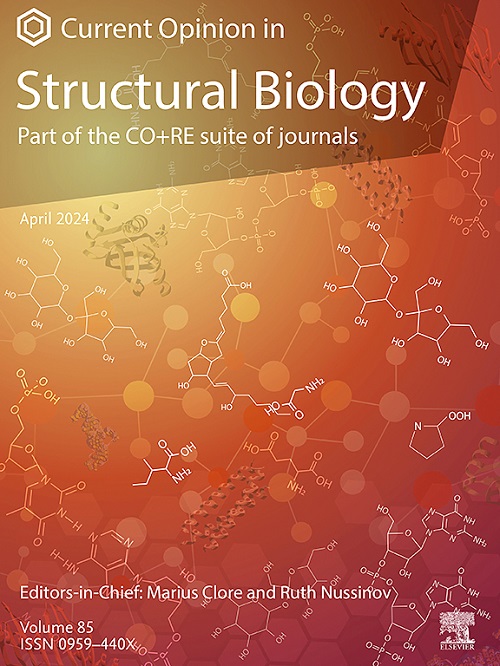模拟生理时间尺度的生物分子
IF 6.1
2区 生物学
Q1 BIOCHEMISTRY & MOLECULAR BIOLOGY
引用次数: 0
摘要
结构生物学的进步为模拟大型装配体的复杂构象运动提供了许多机会。虽然有些模型受到计算资源的限制,但全原子和基于粗粒度结构的模型在阐明集体重排的机制、能量和动力学特性方面特别有效。在这里,我们强调一些最近的例子,其中基于结构的模型(例如:“烟雾”模型)提供了对大尺度过程的长时间动力学的见解。这些模型足以预测能量景观的所有结构特征,其中使用显式溶剂模拟可以精确校准能量学和动力学。总之,对复杂组装体(如病毒融合蛋白或核糖体)的长时间模拟揭示了能量学和结构紊乱的平衡如何驱动生物和疾病过程。本文章由计算机程序翻译,如有差异,请以英文原文为准。
Simulating biomolecules for physiological timescales
Advances in structural biology are providing many opportunities to simulate complex conformational motions in large-scale assemblies. While some models are limited by computational resources, all-atom and coarse-grained structure-based models have been particularly effective at elucidating mechanistic, energetic, and kinetic properties of collective rearrangements. Here, we highlight recent examples where structure-based models (e.g. "SMOG" models) have provided insights into long-timescale dynamics of large-scale processes. These models are sufficient to predict all structural characteristics of the energy landscape, where the use of explicit-solvent simulations has allowed for precise calibration of energetics and kinetics. Together, long-timescale simulations of complex assemblies, such as viral fusion proteins or the ribosome, are revealing how a balance of energetics and structural disorder drives biological and disease processes.
求助全文
通过发布文献求助,成功后即可免费获取论文全文。
去求助
来源期刊

Current opinion in structural biology
生物-生化与分子生物学
CiteScore
12.20
自引率
2.90%
发文量
179
审稿时长
6-12 weeks
期刊介绍:
Current Opinion in Structural Biology (COSB) aims to stimulate scientifically grounded, interdisciplinary, multi-scale debate and exchange of ideas. It contains polished, concise and timely reviews and opinions, with particular emphasis on those articles published in the past two years. In addition to describing recent trends, the authors are encouraged to give their subjective opinion of the topics discussed.
In COSB, we help the reader by providing in a systematic manner:
1. The views of experts on current advances in their field in a clear and readable form.
2. Evaluations of the most interesting papers, annotated by experts, from the great wealth of original publications.
[...]
The subject of Structural Biology is divided into twelve themed sections, each of which is reviewed once a year. Each issue contains two sections, and the amount of space devoted to each section is related to its importance.
-Folding and Binding-
Nucleic acids and their protein complexes-
Macromolecular Machines-
Theory and Simulation-
Sequences and Topology-
New constructs and expression of proteins-
Membranes-
Engineering and Design-
Carbohydrate-protein interactions and glycosylation-
Biophysical and molecular biological methods-
Multi-protein assemblies in signalling-
Catalysis and Regulation
 求助内容:
求助内容: 应助结果提醒方式:
应助结果提醒方式:


